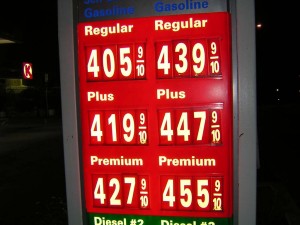Karen Silverman scowls as she starts to fill up her 2007 Jeep Grand Cherokee, the numbers on the dial spinning too fast to follow until the pump clicks off at $62.
“When I got the Jeep, it wouldn’t cost me half that,” she laments. “That’s money I could use for a nice dinner or a movie. Now it just goes to the oil company.”
With much of the country now paying $4 a gallon, and further increases likely, millions of motorists are having to face the same decision as Silverman, a suburban Detroit legal assistant. Prices have risen an average of 80 cents a gallon over the last year, according to the AAA, and they’ve more than doubled since slumping to an average $1.86 a gallon following the mid-2008 fuel scare.
According to various data, Americans are now devoting an average 5% of their income to pay for gasoline, up from a little more than 2% just two years ago.
“The surge in oil prices since the end of last year is already doing significant damage to the economy,” says Mark Zandi, chief economist at Moody’s Analytics.
Economists have been waiting to see consumers increase spending – which accounts for about 70% of the nation’s economy — hoping that will punch things back into gear after the devastating recession.
But not all spending has the same impact on the nation’s financial health. About half of what a motorist like Silverman spends will go directly back to Saudi Arabia, Venezuela or even Canada, the original source of the crude oil. That’s far less helpful to the economy than buying lunch or investing in a new car.
According to Zandi, the rise in fuel prices has already taken its toll, slashing 0.5 percentage points of growth during the first quarter of 2011. If petroleum continues to trade at more than $100 a barrel, he says, the impact would be a 0.3 point decline in economic growth for the year. At $125 a barrel, he forecasts, it would cost a full point of growth. And if the numbers surge past $150, he warns, the U.S. could slip back into recession.
As of mid-Wednesday morning, oil futures were trading above $106 a barrel in New York, but the low-sulfur Ice Brent Crude was going for nearly $122 on the London exchange.
Not everyone thinks that rising fuel prices are the end of the world. Numerous officials in the auto industry – including long-time industry veteran and former GM Vice Chairman Bob Lutz – have actually been hoping to see prices rise in order to promote a shift to more fuel efficient vehicles.
The question is “how quickly prices rise,” Lutz has stressed. Spikes, like the current one, are difficult for consumers to manage and tend to create a psychological shock, experts warn, that can have a chilling impact on the economy. Longer, slower-paced increases, possibly through European-style fuel tax increases, would allow the country to adopt, Lutz and other experts have suggested.
(And you thought you had it bad? Gas is nearly $10 a gallon in parts of Europe – but just 6 cents in Caracas. Click Here for more.)
Right now, motorists are adapting anyway they can, whether by skipping the movie night or, where possible, trimming back on driving.
During the first week of April, a survey of 140,000 U.S. service stations found American motorists bought 2.4 million gallons less fuel, a 2.4% drop, compared to the same period in 2010, according to MasterCard SpendingPulse.
The Oil Price Information Service, meanwhile, reported sales were down in March at 70% of U.S. gas station chains.
The declines are the biggest seen since fuel prices hit record levels in mid-2008 – excluding periods of extreme weather, like the past winter’s massive blizzard.
In decades past, declining usage might have triggered the law of supply-and-demand to kick in, dropping pump prices, but even if American motorists do cut back, global oil demand is expected to increase from 87 million barrels a day, in 2010, to 88 million this year, largely propelled by China and other emerging markets.
And with Mideast supplies disrupted by the ongoing democracy movement – and especially by the civil war in Libya – there’s little excess pumping capacity to hold down the spikes U.S. motorists are seeing, even if they curtail weekend chores and postpone vacation travel.

